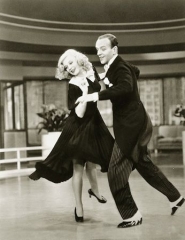Is It Really a Great Movie? Part Six: Swing Time
by dan heaton
Using Roger Ebert's Great Movies book as a guide, this series of articles will focus on all films included on his list that previously have escaped my notice. Since all lists are subjective, I am not treating Ebert's choices as the essential selection of films. However, his essays offer the perfect chance for me to explore both classics and lesser-known pictures from around the globe.

Fred Astaire and Ginger Rogers starred together in 10 films and consistently receive mention as one of the screen’s classic duos. Their complex dance sequences still wow audiences today and effectively support the romantic stories. Many experts consider Swing Time their greatest collaboration and choose it as a favorite film. Time magazine included the 1936 musical in its recent list of the All-Time 100 Movies, and it earned the #30 spot on the American Film Institute’s Top 100 Passions list. Also, the memorable tune “The Way You Look Tonight” received the Academy Award for Best Song. George Stevens directed the picture, and he went on to helm such notable films as Shane, Giant, and The Greatest Story Ever Told.
Much of this Great Movies project involves checking off a list of classic film requirements. Douglas Sirk film. Check. Supposed best film of the ‘70s. Check. Astaire/Rogers film. Check. Swing Time was my initial experience with the charismatic dancing duo, which marks another first in my cinema education. Astaire and Rogers’ last collaboration occurred in 1949, and many fans still consider them one of the greatest movie pairs. Would this picture live up to the hype? The answer is yes if you focus solely on the dance sequences, which remain stunning today. Stevens utilizes long shots and very few cuts to stress their amazing timing and grace. I am far from a lover of musicals, but cannot deny the magic generated during these extended sequences.
Astaire plays John “Lucky” Garnett, a talented showman who journeys to New York City to earn money and assuage the concerns of his fiancée’s father. Joining him is his buddy Everett “Pop” Gardetti (Victor Moore), and their early schemes to get their foot in the door are amusing. A free dance lesson brings Lucky into contact with Penny Carroll (Rogers), a striking, straight-talking gem with considerable dance talent. Their connection is nearly immediate, but his money problems could end the chance before it starts. However, some ingenious gambling gets things moving and sends them in the right direction. The off-screen presence of Lucky’s fiancée looms over their burgeoning relationship, however, while Penny grows enamored with him. The suave Ricky Romero (Georges Metaxa) also hopes for her hand in marriage, and consistently tries to woo her away. Will Lucky and Penny’s chance for love end in heartbreak? Most viewers should know the answer to this question.
The plot of the story is fairly entertaining, but it really just serves as an excuse to offer a structure to present the inventive dance sequences. Arguably the best moment is the first number “Pick Yourself Up,” which occurs at the dance studio and includes several fluid acrobatic moves over a barricade. It also succeeds because it completely surprises Penny, who believes that Lucky has absolutely no rhythm. Joined by the likable Victor Moore and Helen Broderick, Astaire and Rogers showcase the chemistry that made them unforgettable stars. All six major tunes come from Jerome Kern (music) and Dorothy Fields (lyrics), and several of them remain well-known today. “The Way You Look Tonight” is the most recognizable, but the most emotional song is “Never Gonna Dance,” which depicts Lucky’s desperate attempts to woo Penny through dance. Filmed around the top of a grand platform, this number eclipses the straightforward plot and makes their final connection even more significant. The other notable performance is “Mr. Bojangles,” Astaire’s homage to the work of Harlem’s Bill Robinson. Its use of three large shadows projected behind him is stunning, but its effect diminishes due to the use of blackface. I don’t believe this sequence comes from a racist attitude, but it still casts a blemish on some highly original dancing.
Roger Ebert describes the “joy of performance” that helped Fred Astaire and Ginger Rogers’ partnership to eclipse their work with other actors. I totally agree with his assessment, which perfectly describes their great success. Swing Time includes several remarkable dance numbers and flows seamlessly through the required plot. The story does feel dated and stumbles on several occasions, but it stays afloat due to Astaire and Rogers’ excellence. Her work is especially stunning and reveals a star at the top of her craft. This film may turn off some modern viewers with its predictable story and Hollywood elements, but it does warrant inclusion in a Great Movies list. The renowned couple’s work remains entertaining today and should continue to inspire new viewers with their wonderful talent.
Copyright (c) 2006 erasing clouds |
|